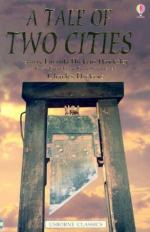|
This section contains 880 words (approx. 3 pages at 300 words per page) |

|
Irony in the Novel "Tale of Two Cities"
In the novel A Tale of Two Cities, written by Charles Dickens, irony is used.
Irony is a name for a surprising, interesting, or humorous coincidences of contradictions in a book The three types of irony are verbal, dramatic, and irony of situation. Verbal irony is when words are used to mean the opposite of their meaning. Dramatic irony is when there is a contradiction between what the character knows and what the reader thinks. Irony of situation is when the eventual outcome is completely different than the reader thinks. Dickens uses each one of these types of irony to help tie his book together and to keep the readers on the edge of their seats.
Verbal irony is used many time in A Tale of Two Cities. It is used when Mr. Lorry talks about himself being a man of business. "Miss Manette, I am...
|
This section contains 880 words (approx. 3 pages at 300 words per page) |

|


